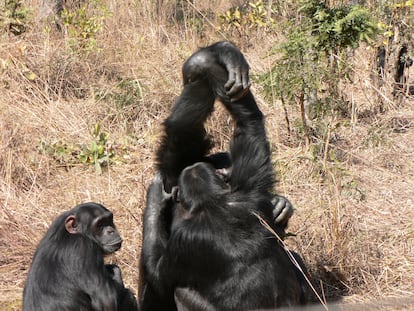Susana Monsó, philosopher: ‘Studying how animals experience death helps us to naturalize our own grief’
The author of one of the first books to compare death between species also leads the first philosophy of mind and behavior of animals association

The recurrent statement “humans are the only animal that...,” followed by any supposed ability or uniqueness exclusive to our species, exasperates scientists who study animal behavior, since the scientific evidence of the last decades has been very enlightening in this regard. We make these statements without stopping to study the entire animal kingdom. “If recent history has shown us anything, it’s that we have to be very careful about saying that,” comments animal mind philosopher Susana Monsó. For her, an iconic event that changed everything occurred in the 1960s: “Jane Goodall came along and saw chimpanzees using tools, but since then we’ve discovered it in ants.
The list of characteristics that were thought to be exclusively human but are not is impossible to summarize: monkeys that kill others, octopuses that dream, elephants that recognize themselves in the mirror, orcas with a shared hunting culture, crows that solve puzzles, wolves that show compassion in the group, and even animals that watch over the bodies of their companions or relatives because they understand what it means to die. On this last topic, in 2021, Monsó published La zarigüeya de Schrödinger: Cómo viven y entienden la muerte los animales (or Schrödinger’s Possum: How Animals Experience and Understand Death, which will soon be available in other languages). Its aim was to update everything that was known about the field of comparative thanatology, which is now a little more than a decade old.
Monsó's idea is to scrutinize the dynamics that other species show with death, using the systematic magnifying glass of philosophy: do other animals understand finitude in their own terms? It is a controversial notion, which until recently was rejected by the discipline itself. For the Spanish researcher, a professor at UNED (the Spanish distance learning university), her work is a way to broaden the relationship between humans and the animal kingdom. All the new knowledge, inevitably, also causes the “only animal that brings flowers to its dead” to compare itself to other animals.
Monsó inaugurated the first international meeting of the Philosophy of Animal Minds and Behavior Research (PAMBA) in Madrid last April, a new branch of knowledge focused on studying how each species understands its niche in the world.
Question: How is death in the animal kingdom studied?
Answer: Comparative thanatology is the study of the relationship between animals and death and was born about 10 years ago; therefore, it is still a very young discipline and needs a philosophical conceptual analysis. In the case of death, there are many debates going on, but it is that the concept of death has been defined in a very intellectual and binary way: either you understand it as humans do, as an average adult, or not at all. And of course, this is a very problematic way of asking this question and, moreover, it makes it very uninteresting.
Q. You speak of a minimal idea of death, something that can be extended to almost all species.
A. Obviously, animals that lack, say, an oral culture such as ours do not have such a complex concept embedded in a whole series of rituals, emotional meanings, traditions, etc. It is more interesting to think whether animals possess a notion of death in their reality. Hence, I defend the minimal concept of death as a spectrum, with different degrees of complexity linked to the abilities of those animals to survive. The idea is to start from this initial basic concept, so as not to put the cart before the horse, and then explore how complex the relationship with death becomes in non-human animals.
It is a very intuitive idea if we think about the case of human children, who do not develop a concept of death overnight, but it takes them quite a few years, up to 10 according to developmental psychologists. Before having a full idea, children present a notion.
Q. Has death been over-intellectualized to exclude the fact that the rest of the animal kingdom also understands it?
A. Only the human-like behavior was sought in other animals and that has been a barrier to understanding their emotions. The discipline of comparative thanatology arose due to a paper published in 2010, describing how a group of chimpanzees reacts to the death of an older female. Scientists describe a series of behaviors that would be analogous to human behavior around death: nocturnal vigils and anticipatory mourning. They conclude their work by saying that having found these behaviors, reminiscent of humans, demonstrates the interest in studying the relationship of animals to death. This is another way of saying that the chimpanzees’ relationship with death is not interesting per se, but that it is interesting if it is similar to how human relate to it. I find it super interesting in itself, regardless of their similarity to us.
Q. “Emotional anthropocentrism,” is how you describe it in the book.
A. Of course. We are looking for emotional reactions to death in animals that only remind us of human reactions, and that has led studies to focus almost exclusively on the mourning stage. Which is interesting and important, but it is only a small part of the story, there is so much more.
Some behaviors surrounding death in animals are adaptive, such as necrophobia: that a decomposing corpse is disgusting. But there is an emotional mechanism in those mothers who carry their dead offspring, something is stronger there.
Q. You give a lot of importance to violent scenarios, because that’s where most of the animals move in the wild.
A. I claim them as a field of study because it is a perfect culture for the concept of death to emerge. There the animal is dicing with death itself, and then that makes the stimulus suddenly become much more evident. The animal learns a minimal concept of death based on its own day-to-day experience, which means that the animal has an inductive base. Hence I can infer, in the case of an animal that has a great deal of experience with death, that it is both predator and prey, constantly having to hunt others and constantly under the threat of being hunted. Perhaps it may come to develop a notion of its own mortality. A component of inevitability: I can die if I am unlucky and run into the predator, but I can also get away with it.
Q. Would it have an adaptive component?
A. There is a lot of discussion about this. Some behaviors around death in animals that are clearly adaptive and thus do not seem to depend on learning. For example, necrophobia: the fact that a decomposing corpse is disgusting. We do not eat carcasses because they are a source of pathogens. It’s very adaptive: it disgusts you, so you don’t go near it.
But suddenly things like grief get mixed in, and we start to see behaviors that seem maladaptive. Like the mothers of some species that carry their dead offspring for weeks, even if they are decomposing, and are very disgusting to the other members of the group, who avoid the mother because she stinks. There is something, an emotional mechanism that acts as a motivation that is stronger than necrophobia.

Q. You criticize the fact that philosophy has claimed concepts such as eternity or infinity as the only way to understand death.
A. It has been shown that it is not necessary nor would it be necessary. It was said that it was necessary to have these great ideas for the western citizen to understand the absence or non-existence. What would an animal have to think to understand death? Death has been linked to super abstract notions, such as eternity, absence or infinity, and it seems to me that this is very much infected by our own vision of death. In our westernized societies, where the dead are immediately removed from our sight, we conceive of death as an absence. Because for us someone dies and, bang! Suddenly they are completely absent.
For example, the notion of absence means nothing to an animal that, like a monkey, carries its dead baby for weeks. There is no absence, the baby is still there and what there is is an absence of certain vital functions, but the body is still present. Then, death becomes something much more tangible: the mother can see this absence of functions, she can hear it, she can feel it, it is multimodal, let’s say. I think we should be careful not to transfer all of our cultural experience around death because some are simply very particular to our relationship with it and do not apply to all animals.
Q. How does the approach you advocate in your book change the relationship humans have with death?
A. It’s been very nice that it’s reaching people in ways that I didn’t expect. It’s not the goal, but it’s great that the book helps people get through a grieving process and that a person feels better. It happens to me many times that in a presentation someone will say to me, “You were talking about this, and I remembered the death of my dog.” Or have someone tell me that they have a lot to thank me for because they had read my book while their mother was dying, and reading it had allowed them to cope with that loss better. Somehow, it had helped them to naturalize the grieving process. You don’t expect that.
In talking about animal behavior, I didn’t expect it to help people process their grief, whether with their relatives or their pets.
Q. It breaks with the feeling that the subject must be gloomy; and philosophy must be leaden.
A. What I wanted was for the book not to be a downer and not to make people depressed, even though there are hard times that need to be talked about. When I explained my field of study to colleagues, I realized that the subject was interesting but then left a certain discomfort: you could see it in their body language, they remained hunched over, sad because, of course, I had made them reflect on the inevitability of death. That’s why I always try to get the joke in as soon as I can. Even my own mother told me to take the death thing out of the title, but that would be false advertising!
Q. You wrote that you now wish to investigate other aspects of the animal world.
A. I am trying, but it is difficult. I would like to move on to other things for the simple fact that I always like to change the subject. Other fields for me to direct my research: aesthetics and medicinal behaviors of animals. But I think I still have some time left to be the mistress of death [laughs], the goth of animal cognition.
Sign up for our weekly newsletter to get more English-language news coverage from EL PAÍS USA Edition
Tu suscripción se está usando en otro dispositivo
¿Quieres añadir otro usuario a tu suscripción?
Si continúas leyendo en este dispositivo, no se podrá leer en el otro.
FlechaTu suscripción se está usando en otro dispositivo y solo puedes acceder a EL PAÍS desde un dispositivo a la vez.
Si quieres compartir tu cuenta, cambia tu suscripción a la modalidad Premium, así podrás añadir otro usuario. Cada uno accederá con su propia cuenta de email, lo que os permitirá personalizar vuestra experiencia en EL PAÍS.
¿Tienes una suscripción de empresa? Accede aquí para contratar más cuentas.
En el caso de no saber quién está usando tu cuenta, te recomendamos cambiar tu contraseña aquí.
Si decides continuar compartiendo tu cuenta, este mensaje se mostrará en tu dispositivo y en el de la otra persona que está usando tu cuenta de forma indefinida, afectando a tu experiencia de lectura. Puedes consultar aquí los términos y condiciones de la suscripción digital.
More information
Archived In
Últimas noticias
Most viewed
- Sinaloa Cartel war is taking its toll on Los Chapitos
- Oona Chaplin: ‘I told James Cameron that I was living in a treehouse and starting a permaculture project with a friend’
- Reinhard Genzel, Nobel laureate in physics: ‘One-minute videos will never give you the truth’
- Why the price of coffee has skyrocketed: from Brazilian plantations to specialty coffee houses
- Silver prices are going crazy: This is what’s fueling the rally










































